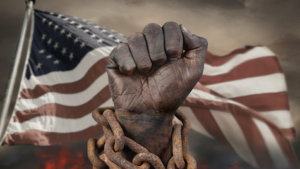This paper records the path by which African Americans were transformed from enslaved persons in the American economy to partial participants in the progress of the economy. The path was not monotonic, and we organize our tale by periods in which inclusiveness rose and fell. The history we recount demonstrates the staying power of the myth of black inferiority held by a changing white majority as the economy expanded dramatically. Slavery was outlawed after the Civil War, and blacks began to participate in American politics en masse for the first time during Reconstruction. This process met with white resistance, and black inclusion in the growing economy fell as the Gilded Age followed and white political will for black political participation faded. The Second World War also was followed by prosperity in which blacks were included more fully into the white economy, but still not completely. The Civil Rights Movement proved no more durable than Reconstruction, and blacks lost ground as the 20th century ended in the growth of a New Gilded Age. Resources that could be used to improve the welfare of whites and blacks continue to be spent on the continued repressions of blacks.
Working Paper
Inclusive American Economic History: Containing Slaves, Freedmen, Jim Crow Laws, and the Great Migration
Working Paper Series By
Working Paper Series By
Download- Logan Temin Race Inclusive Inet Working Paper Final (pdf, 1.16 MB)




